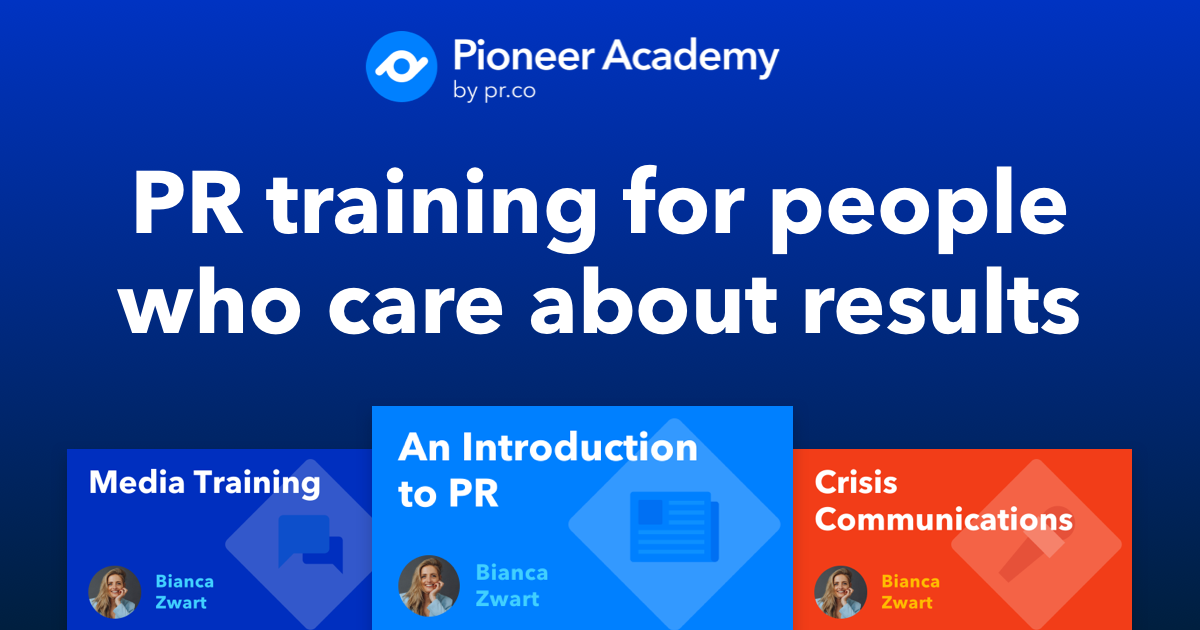Today’s event software makes hosting sleek, memorable virtual events easy. Plus, there are a million ways to keep participants entertained, from setting up virtual campfires to pushing their flavor boundaries while promoting your brand online.
Take your next virtual event from ho-hum to halleluja with this go-to guide.
Virtual Events Defined
Virtual or online events include experiences like live streams, webinars, virtual trade shows, and other events that occur entirely in the digital realm. Software like Microsoft Teams, Google Meet, and Zoom are widely used, but virtual events can also occur in virtual or augmented reality (VR or AR) settings.

Our way of work has dramatically transformed over the past few years, with virtual events evolving from a pandemic necessity to a strategic PR choice. Virtual events can deliver real value for your brand when planned carefully.
The most successful virtual events use digital spaces to craft experiences that are impossible to replicate in person. Take influencer Kai Cenat’s groundbreaking livestream, which gave millions of viewers worldwide an intimate, behind-the-scenes look at Snoop Dogg’s creative process. This level of access would be logistically impossible in a physical venue.
While we can’t all feature celebrities every time, the core principle remains: Exceptional virtual events thrive on exclusive, compelling content that resonates with your audience. Whether launching a product, hosting a workshop, or organizing a press conference, this focus on value can transform an ordinary online gathering into a must-attend experience.
The Benefits of Hosting a Virtual Event
Think virtual events can’t compete with physical events? Think again.
Virtual events offer unique advantages that traditional conferences can’t match.
Global reach with minimal effort
Hosting virtual conferences or events is one of the easiest ways to promote your brand ideas to an international audience—without the logistical nightmare of getting everyone together under one roof.
Virtual events also give you a unique opportunity to make your event accessible, which can attract a wider audience. 
Lower costs
In-person events typically rack up substantial costs, from hiring venues and audiovisual equipment to catering.
Going digital can significantly cut costs while delivering a great experience. The key is to tap into interactive tools like polls, Q&A sessions, custom visuals, chat features, and augmented reality.
Content that keeps working for you
Virtual conferences can double as content goldmines—minus the hefty price tag of recording in-person sessions.
From on-demand webinars, eLearning guides, and whitepapers to shareable social media clips, event content can easily be repurposed to keep the buzz going long after it’s over. This extended lifespan multiplies your event’s impact, allowing audiences to engage with your content whenever and however they prefer.
A great example is Adobe’s 2024 MAX conference, which spawned extensive on-demand content and interactive apps that remain accessible to everyone.

Less travel, more sustainability
Virtual events dramatically reduce environmental impact—no one has to travel, and there’s zero physical waste. Both factors can demonstrate your organization’s commitment to environmental stewardship.
PwC’s Voice of the Consumer survey confirms this approach resonates strongly with today’s audiences, who increasingly prioritize sustainability in their decision-making.
Time savings
Virtual conferences mean less time spent setting up and getting everything ready to host a thousand (or more) people.
Going the online route also eliminates stressful commutes, allowing virtual attendees to start their day relaxed and focused from their own workspace.
Instant insights and powerful data
Today’s best virtual event platforms allow brands to track real-time engagement and event attendance. Interactive features like polls and social media integration provide immediate audience feedback, giving PR teams valuable insights on the fly.
PR teams can use the data to tailor the event experience in real-time or refine their approach for future events.
More importantly, virtual events can help PR professionals build strong customer databases for their brands. “Virtual events are a brilliant tool for data collection, helping your sponsors and exhibitors generate high returns from their investment,” says Zach Butler, Director of Events and Media at TNW.
Virtual Events Best Paired With In-Person Events
While virtual events were a lifeline during COVID-19, in-person events have made a comeback over the last two years. In 2025, many of the world’s top event organizers prefer a hybrid approach.
“I see hybrid or virtual elements as value adds to an in-person experience, not a replacement,” Zach says. “A hybrid approach allows organizations to leverage the best of both worlds—the energy of in-person connections with the reach and accessibility of virtual components.”
Being unable to meet and network face-to-face during the pandemic has left its mark on the events landscape. “The pandemic gave us a stronger-than-ever confirmation that human interaction is part of life. The rebounds to physical are stronger than ever,” Zach notes.
Online Event Best Practices
Just like real-life events, the success of the virtual kind requires careful planning.
Here are three essential strategies to ensure your virtual event or online experience delivers exceptional value:
Create a branded virtual environment
While virtual platforms like Zoom and Microsoft Teams offer great features, their prominent branding can overshadow the brand you’re trying to build.
Create a distinctive event environment by using a customizable platform that seamlessly integrates your logo, brand colors, and typography to deliver an immersive, memorable brand experience.
When JBL celebrated it's 75th anniversary, they hosted a live event on their branded newsroom. Check it out.
Test your hardware ahead of time
Although virtual events require less setup than in-person gatherings, thorough technical testing remains critical. Technical issues and connectivity problems can derail even the most meticulously planned session.
Check your audio and visual equipment beforehand and double-check that your event speakers are comfortable using your chosen platform. Establish dedicated technical support channels for presenters to address any potential issues during the event.
Insider tip: Conducting full technical rehearsals can help you identify and resolve potential issues before the event.
Don’t just broadcast—engage
Virtual events allow you to forge emotional connections with your audience and create a lasting impact if done well. Therefore, it’s critical to take the time to plan an interactive experience that will drive high attendee engagement.
Effective virtual events prioritize dynamic audience engagement over one-way presentations. Never talk at your audience—instead, use Q&A sessions to loop your participants into the conversation and think of ways to create networking opportunities. Features like breakout rooms can help you build even stronger personal connections.
Accepting that you’re dealing with various distractions while hosting a virtual event is important. Participants get messages via email, Slack, social media, WhatsApp, and various other platforms while they’re attending. “Try and work with these distractions rather than compete with them,” Zach advises.
Many brands use social media and chat platforms to engage their target audiences and create more impactful events. One example is the beauty brand Sephora, which successfully engaged its community of beauty enthusiasts during a virtual Reddit AMA (“Ask me Anything”), covering everything from product questions to gift suggestions during a lively chat.
Insider tip: Check out our pick of the top 9 virtual events for more inspiration.
Consider presenter dynamics
Carefully consider whether your event speakers would make for an impactful virtual event that will appeal to your target audience.
“Some people that are good at presenting in-person are not good at presenting virtually,” Zach notes. “When selecting speakers, consider their ability to engage effectively through a screen.”
It’s also critical to consider factors like camera position, environment, and lightning—all of which can help presenters communicate effectively with your target audience during virtual events.
Insider tip: Consider creating pre-recorded content with presenters who may be uncomfortable to present live.
Common Virtual Event Challenges
Virtual events come with their own set of challenges. Keep an eye on the following as you start planning:
Beware ‘Zoom fatigue’
We all know what Zoom fatigue—the official term the Harvard Business Review uses to describe the feeling of being “over virtual meetings”—feels like.
Sadly, attending another online event can feel like a chore for your audience. Plan carefully to ensure you rev up participants’ engines instead of boring them to tears. Once again, a hybrid approach could be the best way to capture—and hold—your target audience’s attention.
Low turnout
Low turnout rates are a common problem for digital events, as opting out of a digital event is much easier than skipping one IRL.
Addressing this problem involves strategically targeting potential attendees (i.e., identifying your ideal audience), building hype, and providing perks or freebies.
Insider tip: Use post-event surveys to determine why you didn't attract a larger audience.
Building a connection
It can be challenging to get virtual participants to interact when everyone is sitting behind a screen. Without face-to-face social cues, they may feel disconnected or hesitant to engage. This reduced interaction could mean they lose interest or don’t make strong connections.
Running structured networking sessions or even impromptu chats are great ways to overcome this problem.
5 Types of Virtual Events
As each virtual event format serves distinct strategic objectives, it’s important to know what your options are. Let’s run through five of the most popular virtual event types:
Webinars
Educational webinars have emerged as a powerful tool for organizations to showcase thought leadership and provide in-depth insights about their products and industry expertise.
Live sessions facilitate dynamic Q&A engagement, while on-demand webinars can extend your content’s reach and accessibility.
Get inspired by HubSpot’s webinars. They’re pros at creating this type of event.
Virtual exhibitions
When selling a product or experience, exhibitions are your best friend. Running one online offers unique opportunities, like having a live chat everyone can access or linking visitors to additional online resources.
They’re also an excellent choice for highly creative brands, as they give brands a platform for showcasing their most “out there” ideas.
See Balenciaga’s upcoming virtual reality show for a taste of what’s possible with the latest virtual event solutions.

In 2023, global art marketplace Artsy launched an online art fair called Foundations. Small and upcoming galleries in their network curated pieces from early-career artists in an online gallery space.
Virtual trade shows
Virtual trade shows, like their in-person counterparts, connect buyers, vendors, and industry professionals in a dynamic environment where they can mingle and discuss the latest industry trends and products.
If you’re organizing a virtual trade show, include keynote sessions, virtual networking spaces, and product demos for maximum impact. Check out this great travel industry example from One Caribbean Canada.
Virtual press conferences
In-person press conferences allow your brand to engage press interest in new products or offerings. The virtual version fulfills the same function but can amplify your announcements across more diverse media channels and markets, attracting more potential attendees.
See how NASA used a virtual press conference for a recent Artemis campaign update.
Hybrid events
Going virtual doesn’t mean you have to give up on in-person events. In fact, quite the opposite. Today’s top brands opt for hybrid events that blend real-world and virtual access for ultimate impact.
A great example is the 2025 Consumer Electronics Show (CES 2025), which blended ultra-sleek in-person tech demonstrations with a dedicated YouTube channel that allowed anyone, anywhere, to join in the excitement. The upshot? Dramatically expanded audience reach and sustained industry conversation long after the event concluded.
The Future of Virtual Events
These formats, examples, and tactics showcase just a fraction of what’s possible in today’s virtual event landscape. The tech underlying virtual event success is improving daily, with artificial intelligence shaking up how we interact in the virtual world.
Emerging technologies like AR, VR, and the metaverse are also changing the landscape, as demonstrated by this intriguing DeadMau5/Soundscape metaverse collab:
These innovations signal a future where virtual events will offer increasingly sophisticated levels of interactivity and immersion for virtual audiences.
Keep an eye on all the latest trends and developments by regularly checking the PR.co blog.
Achieve Virtual Event Perfection With PR.co
Researching the best virtual event solutions? PR.co builds software that helps ambitious PR teams host high-impact online events and virtual experiences.
Our easy-to-use virtual events platform streamlines the delivery of press conferences, webinars, and other digital events while maintaining your brand’s visual identity throughout the experience.
Get your brand the attention it deserves with a successful event—request a product demo.
Sjors Mahler is the Commercial Director at pr.co. He’s worked with PR and communications teams for 9 years and has organized dozens of meetups and events for the Amsterdam PR community. Sjors has an MSc in Persuasive Communications and specializes in branding, sales strategy, and inbound PR.. Connect on LinkedIn or send an email







